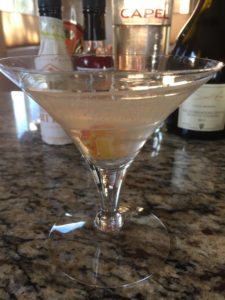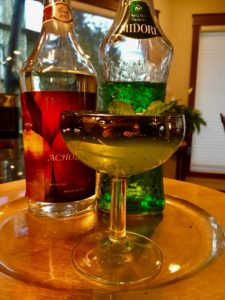Episode 140: Pisco Unpacked
We called this episode Pisco Unpacked because the W25 ladies mixed up some pisco-based cocktails this week. We thought it would be fun to “unpack” some 411 on the national spirit of Peru. Also produced in Chile, pisco has a long history, and we’re diving into the grapes, styles, and its versatility. We hope you pick up a pisco nugget to add to your brandy or cocktail repertoire.
(Recorded November 2017)
In our Glasses
Val: Pisco and Prosecco, or “P-Squared” Cocktail.

- 1 oz Pisco
- ½ oz Triple sec
- ¼ oz Lemon juice
- 1 dash orange bitters
- 2 dashes aromatic bitters
- 2 oz Prosecco
- Dried orange & lemon wedges for garnish – because, why not?
The pisco used for this cocktail was Capel pisco from Chile, made with Muscat, Pedro Jimenez, and Torontel grapes, aged about five months in wood.
Steph: “Minty Quinn” (thanks to Steph’s buddy Cheryl)

- 1.5 oz Pisco
- 0.5 oz Midori
- 1.25 oz strained cucumber juice
- 6 mint leaves plus a sprig for garnish
- ½ lime, juiced
Muddle the mint leaves with the lime juice and ice in a cocktail shaker. Add the cucumber juice, Pisco and Midori and shake it up. Strain into a cocktail glass and garnish with mint sprig.
The pisco used for this cocktail is from Bodega Payet in Peru. It is an acholado style and is vintage dated 2011 ($29). The five grape varieties used in this pisco are Quebranta, Torontel, Moscatel, Albilla and Pink italia.
The back label states: “Excellent on desserts, ice cream, chocolate, or as a reading room mate.” Of course, we find this an amusing talking point during this recording. It’s what we do.
Pisco Unpacked
What It Is
Pisco is a clear, colorless distillate from fermented grapes (aka wine). You can think of it as brandy. Peru and Chile are the only countries allowed to produce a product by the name “pisco.”
A South American Specialty
Pisco is Peru’s national spirit and it is exported to 44 different countries.
The word “pisco” has many origins. Some say it is of the Quencha language, meaning “bird,” and also the name of the Peruvian colonial port town of Pisco. Others say it comes from the word “pishku” meaning “something boiled in a pot” from the Mapuche people of Chile and Argentina. Who really knows for sure.
So when did Peru start producing Pisco? Well, Peru was making wine in the 1500s, but the Spanish Crown didn’t like the Peruvians competing with their wine business ventures in the world and therefore taxed it, banned exportation, and also banned the establishment of new vineyards. The Peruvians started distilling the wine in response to all this. But then the earthquake in 1687 brought most of the wine production to a halt. Over the years, pisco production followed the wine production, which basically was barely humping along. Wars, struggling economies and all those not-so-fun things got in the way of the wine growers and subsequently distillers.
Peruvian Pisco
In Peru, they are fussy about their prized pisco. There are rules, and they are not for breaking.
There are five DOs (Denomination of Origin) departments: Lima, Ica, Arequipa, Moquegua, and three valleys in the Tacna. The Pisco has to made in a copper still, it cannot be diluted, must be bottled at the distillation strength and cannot have anything added to it.
The eight grape varieties (according to piscoworld.com – and yes, it’s a thing) allowed to make Peruvian Pisco are Quebranta, Uvina, Negro Corriente (aka Negra Criolla) and Mollar plus the aromatic grapes Torontel (aka Torrontes), Moscatel (aka Muscat), Italia, Albilla. Quebranta is the most widely used of all the grapes.
There are four designated Peruvian Pisco types or styles.
- Mosto Verde (green must) = distilled from partially fermented must
- Puro (pure) = single variety of grape
- Acholado (multivarietal) = blended from various grape varieties
- Aromaticas (aromatic) = single grape variety such as the aromatic Moscatel, Albilla, Italia and Torontel
It also has to be aged (or rested) for a minimum of three months in stainless steel, glass or a vessel that doesn’t add any flavor, color, etc.
For more information about Peruvian Pisco, the official governing guidelines can be found at CONAPISCO – http://www.conapisco.org.pe/
Chilean Pisco
Chilean Pisco, you say?
Yes, Pisco is also produced in Chile, and the two countries have quite a hot rivalry when it comes to Pisco. Chile has two DO regions – Atacama and Coquimbo, specifically the Elqui Valley.
In fact, we were both drinking Chilean Negroni cocktails back in Episode 50 with this very same Pisco!
There used to be three grape varieties permitted in Chilean Pisco: Moscatel (Muscat of Alexandria), Pedro Jimenez, Torontel (which is a cross between Moscatel Amarillo and Moscatel). However, there are now five, adding Pink Muscat and Torrontés Sanjuanino to the mix. (NOTE: This is different than the Torrontés Riojano or Torrontés we see on Argentinian wine labels).
There are also different types of the Chilean Piscos based on aging:
Trasparente/Pisco Blanco – “Transparent” pisco is clear, and aged in steel, neutral wood, or glass so as not to transfer color, for at least two months
Pisco de guarda – aged in oak for at least six months
Pisco envejecido – aged for a year minimum in French or American oak
Another difference is that Chile regulates its Pisco based on minimum alcohol content beginning at 30% abv for traditional to a minimum 43% abv for Gran Pisco.
More information on Chilean Pisco production rules – and some absolutely gorgeous videos – can be found at Pisco Chile: http://piscochile.com/pisco/
What to do With It
Have you heard of the famous Pisco Sour? The drink dates back to 1916 and was born in Lima, Peru at the Morris Bar. The inventor of the cocktail was an American named Victor Morris. He created the drink when he needed to substitute whiskey in the traditional whiskey sours because he was going to run out of whiskey for a large event. The Morris Bar was one of those high society places in Lima where all the fancy people go.
When you make one, you can dial in the sweetness however you like by adding more or less simple syrup.
The basic recipe for a Pisco Sour:
- 3 oz Pisco
- 1 oz lemon juice
- 1 oz simple syrup
- 1 oz egg white
Shake it up and strain into a cocktail glass. Add three drops of Angostura bitters on top for decoration and aromatics.
But use your imagination! Pisco can be appreciated in its simplicity or substituted for other spirits in traditional drinks. Of course, you won’t be surprised, that it is mixed in cola, coffee (shh – don’t tell Val), and even beer. Try it in a vodka drink, use it instead of tequila, or pull up a chair next to you so the Pisco can be your “reading room mate.”
Wino Radar
 Eight-Day Peru Food Tour with Taste Vacations, April 9 – 16, 2018
Eight-Day Peru Food Tour with Taste Vacations, April 9 – 16, 2018
Visit the actual town of Pisco! Dine at the #1 ranked restaurant in Latin America called Astrid y Gastón.
Stay at a hotel located in a vineyard. Plus there’s cooking classes, brewery tours, and a visit to Machu Picchu.
Reminders
#W25BookClub *UPDATE*
Our next book is a recommendation from Patron and friend Cathey Love in Tennessee. It is the autobiography A Glass Full of Miracles by Mike Grgich. We’ve pushed back the date a bit due to some travel, holiday, and logistical events.
We love this suggestion Cathey posted on our Facebook community page because of two reasons: Mike’s daughter, Violet Grgich, was a guest on this podcast a year ago in Episode 79; and 2017 marks Grgich Hill’s 40th anniversary.
Also, with regard to the devastating California wildfires, Grgich Hills is safe and open for business.
Reminders:
- Please use the #W25BookClub on social media!
- You can easily order the book right here.
- The Book Review Episode will record on January 25th, so you have some extra time to get in your comments!
Patreon Love
Thank you to our Patrons who support us on our Patreon crowdfunding platform. We are so thankful for ALL of you!
“TENacious Tasters”
- Jeff E from the We Like Drinking podcast
- Lynn from Savor the Harvest blog
- Sebastian of Sassi Italy Tours
- Jen in Maryland (and the world, according to her Instagram feed)
- David and Lisa in Illinois
“It’s not five o’clock and we don’t care” Listeners
- Clay in Arizona
- Jon in California
- Andrew in California
- Aswani in California
- Chris and Janet in Colorado
- Diane in Colorado
- Cathie in Georgia
- Steve in Illinois
- Renee in Illinois
- Ashley in North Carolina
- Chantel in Ontario, Canada
- Mary Lou in Pennsylvania
- Meg in South Dakota
- Cathey in Tennessee
Our newest listener (as of the day before this episode aired): Sean M. in Ohio!
“Tastemaker” Listeners
- David in Scotland
- Carole in Kentucky
- Karen in California
Go to our Patreon page for details www.patreon.com/winetwofivepodcast on how to be entered into our monthly drawing, exclusive content, and swag.
Connect
We are here for you every week… and in between episodes, you can find us on the social spaces @WineTwoFive and we encourage you to join our private FaceBook group called Wine Two Five Community!
Connect with Val on Twitter @WineGalUnboxed and as Vino With Val on Facebook, Instagram & Pinterest.
Connect with Steph on Twitter, Pinterest and Instagram as TheWineHeroine.
Listen
Listen to the entire episode (recorded November, 2017).